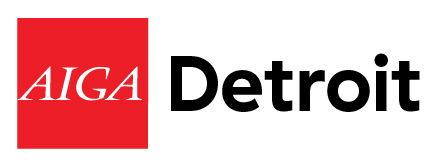Name: Terry Sieting
Title: Associate Creative Director
Company: Traction
Number of Years in Design: 10 Years(IncludesEducation)
Past Companies: Güd Marketing, Michigan State University, Haworth
Education: BA Creative Advertising, Communication Arts & Sciences, Michigan State University
Member Since: 2011
Who has been the most influential person in your career?
Two individuals hold that title: Henry Brimmer & Michael Bierut.
As a freshman at MSU, I studied human biology with hopes of becoming a doctor. In the midst of a packed chemistry class near the end of my first semester, I decided I no longer wanted to pursue a career in medicine. The following semester I enrolled in as many introductory courses as I could, hungry to discover a new passion. As a musician and lover of the arts, it was only natural for me to be drawn to, and ultimately chose, a career in design.
Henry became a part of this journey at the beginning of my junior year. I had only now spent a year diving into the world of ligatures and logos. Enter one Professor Brimmer. On the second floor of a crowded communications building, Henry would imbue his passion for design on to an eager group of MSU students. His classes involved trial-by-fire exercises and large doses of visual inspiration. His animated style and non-traditional approach to teaching intimidated some and brought others to find their voice and style.
Henry’s love for design and minimalistic style are still apart of my DNA as a designer. I owe many thanks to him and his persistent push for excellence.
As I moved into my professional career, I looked back to the visual inspiration Henry had once provided as a starting point for many projects. One specific source had been a student subscription to Communication Arts magazine. It was between the pages of a heavily-used design annual that I came to discover Michael Bierut.
Michael Bierut is a partner and designer at the firm Pentagram, located in New York City. His work is renowned and considered some of the best in branding. Michael and I have never met, outside of a book signing, nor does he know anything about me. But, it was through Michael’s counsel that I have come to call him a mentor.
“When people look for mentors, they often think it’s something that’s done to them, but it isn’t. You don’t have to ask permission; you don’t even have to know the person. These days, you can read so much online.” – Michael Bierut
Having read Michael’s books, listened to his podcasts, and watched many of his videos, I now execute based on his expertise and guidance. Michael’s love for brand and typography have inspired me the world over and have come to mold me into the designer I am today.
What is your favorite thing about design?
Speaking quite literally, my favorite niche of design is identity design. For me, identity design is the perfect meld of art and science, form and function. The art/form aspect can be enjoyable because of the immense amount of effort placed on aesthetics and tonality. While, the science/function facet can equally be as fun, working with psychology and theory.
Through identity design, I’ve come to discover a real passion for typography. Language is rooted in culture and often provides an intimate glimpse into people’s lives. Typography and type design can help take written language and give it character and tone. My favorite fonts span the gamuts of time and style—from Paul Renner’s Futura to Klim Type Foundry’s Pitch.
I genuinely believe great typography is paramount to building great brands. Massimo Vignelli’s and Paula Scher’s creations are proof in the pudding.
What is the most memorable moment of your career?
Although I can’t nail down a specific moment, the moments that have meant the most were those I spent with students, mentoring them at the beginning of their creative journeys. Several of those individuals have gone on to do great things. The occasional call to hear about their success has meant a lot to me. I can only hope that a little of what I said helped them become the creatives they are today.
What advice would you give to someone just getting started in the design world?
I have four pieces of advice:
- Become a sponge: Subject yourself to sensory overload and absorb as much visual inspiration as you possibly can. One of the most important things you can do as a young creative is develop an appreciation for design and a taste for what is good.
- Keeping learning: Being a great designer requires a thirst for knowledge. I have found the more I learn about the history of design, the more it influences my work. Not into reading? Learn how to set wood or metal type, teach yourself a bit of code, spend an hour with a photographer. There is no shortage of information to be learned or to find influential.
- Do passion projects: Not always is the 9:00 to 5:00 pm super exciting or soul quenching. With a drink in hand, coffee or whiskey, charge into your mornings or nights with a drive to achieve something fun or meaningful.
- Get involved: Join after-work groups and associations like AIGA Detroit. You won’t bump into your next boss if you aren’t open to meeting him or her. Not to mention, these organizations are an easy way to find like-minded friends.
What is your favorite thing about AIGA Detroit?
My favorite thing about AIGA Detroit is the diversity of events they host. Not to mention, you’re always getting to experience a new part of the city. I have yet to be disappointed!
What inspires you as a designer?
I’m often blown away when I see a piece of design that is smart and representative of an idea. For instance, The Atlantic’s special edition “Commemorating King” publication design by Bobby Martin at OCD. From the photography to typography, each facet was exceptionally well researched and strategically implemented. No aspect of the design was executed in a frivolous manner – rather it was carried out with tact and precision. The way Bobby speaks about the design is quite moving and poetic.
Check out Bobby Martin’s interview about the publication on the Dissection podcast.
What are some of the biggest challenges you’ve faced as a designer and how have you handled them?
The biggest challenge I’ve faced as a designer is not being taken seriously.
From clients and coworkers to family members and friends, there has been no shortage of people in my life that think design is a hobby. Some might, dare I say, think design is an activity any person can achieve by merely choosing Papyrus in their Microsoft Word document.
In all seriousness, through the democratization of design and greater accessibility to creative tools, nearly everyone has gotten a taste of being a graphic designer. This, as we all know, results in outside art direction. When faced with this issue, I swallow my immediate emotions and respond by asking the same kinds of questions that I might ask myself when making a design decision.
For example, if a client asks to change their brand color from blue to green, I might ask,“How does green make you feel?” and,“Does that feeling align with your brand tonality?” Often, the client goes silent or asks for your opinion in return. By asking these kinds of questions, you not only include the client in the creative process, which is all they want, but you were able to show off a bit of knowledge without delivering the verbal equivalent to a pie in the face.
What are you excited to learn or work on next?
Over the past few years, I’ve taken a particular interest in writing. Focusing on a skill outside of the realm of design has helped me to become a more imaginative and well-rounded creative. Now, I look for more opportunities to inject writing into my design and brand identities.
SaveSave
SaveSave
|
By aigadetroit
Published July 31, 2018
|

